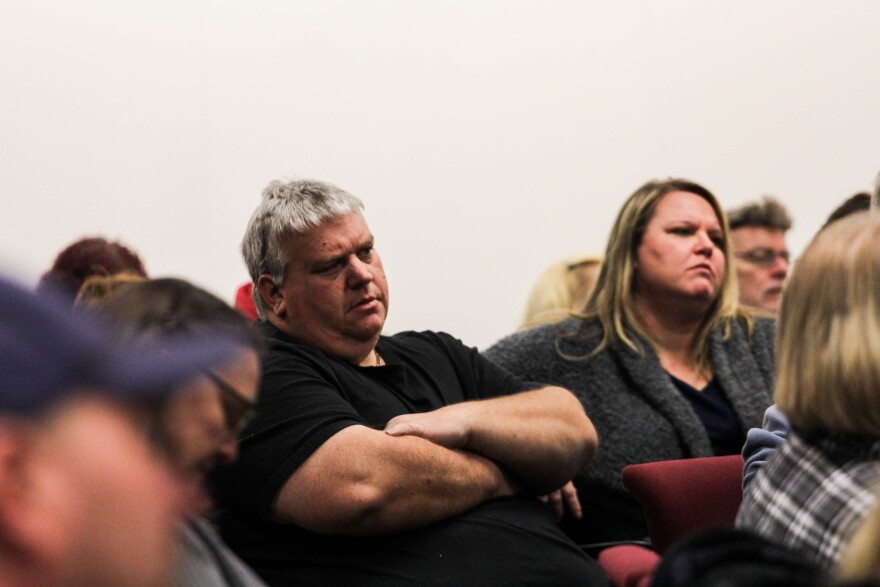When the Environmental Protection Agency on Thursday announced its plan to remove much of the radioactive waste from the West Lake Landfill, some activists and residents celebrated.
But many residents expressed frustration and disappointment that only some of the waste would be removed before the site is covered. They said they’re still concerned about groundwater contamination, which might not be prevented by a partial removal, and worried that they might not be able to move away if the government doesn’t come up with a buyout plan. Some still don’t trust that the EPA can deliver on its promises.
For years, residents and activist group Just Moms have accused the agency of mishandling the landfill and misrepresenting the facts.
Community members have long demanded that the federal government clean up the contamination, which comes from nuclear byproducts dumped at the northwest St. Louis County site in 1973. The EPA debated a solution for decades before proposing that the site be capped in 2006. Residents said then that they worried a cap wouldn’t protect them from radioactivity, and the agency’s internal review board deemed the decision unsatisfactory. The site has sat in limbo since.
Last week, residents learned that the EPA’s new plan would remove 27 percent of the waste — 70 percent of the total radioactivity, according to the agency’s analysis of the site. The EPA maintains that removing this quantity of waste will protect the community’s health long-term.
“Is that going to be enough?”

“I’m concerned that they’re not going to do enough. We talk about 30 percent of the actual mass is going to remove 70 percent of the total contamination, but is that going to be enough?” asked Sally Kincaid, 63, who lives in St. Ann.
Donna Klocke, who lives about a mile and a half from the landfill, is pleased that the EPA committed to a final solution. But Klocke, 74, can’t help but connect the rash of illnesses in her neighborhood to the waste.
“You think, I remember when you were born and now you’re 45 and you’re telling me you have terminal cancer,” she said. “So it’s tough, living with it.”
Some residents say the EPA needs to develop a more comprehensive solution.
“The solution is not okay with me,” said Doug Clemons, the former chair of a community advisory group on the landfill. “It’s good, it’s not great. I’m shooting for great. This community deserves to have a safe place to stay and live. It gets close, but no cigar.”
Klocke also said she plans to push for full removal.
Partial removal might not prevent groundwater contamination
Meagan Beckerman lives in Bridgeton, a few miles from the landfill She said she hopes the agency’s decision isn’t final because she’s worried that a partial cleanup won’t keep toxic chemicals from the groundwater.
Loading...
“If you don’t have clean groundwater then ... I mean the groundwater, especially in this area, flows everywhere. So it just doesn’t make sense to clean up some of the radioactive waste, leave some behind and put a concrete cover it,” Beckerman said. “It doesn’t do anything for our groundwater, nothing for our drinking water.”
West Lake’s cleanup proposal doesn’t address groundwater. The groundwater is a separate Superfund site, which will require its own proposal and remediation. The EPA has studied the groundwater issue, but has no current plans to address the issue.
Residents are still waiting on buyout options from the government

Beckerman said that she’s considering testing her home for radioactive contamination. With incomplete removal of nuclear waste in the landfill’s future, she’s considering moving away — even though she’d prefer to stay.
“I love my community, I love the schools,” she said. “I love everything about it except for the landfill.”
Mike Mason, who lives in the nearby subdivision of Spanish Village with his wife, said that he’d relocate without hesitation, if he had the option. But he can’t afford the financial risk.
“We’re still kind of stuck,” he said. “Can’t sell your house if you’re not going to get anything for it.”
Missouri lawmakers have introduced several bills that would have bought out the homes of people living near West Lake Landfill. None passed; the bill in 2017 made some progress, but failed after a series of funding cuts.
Can the EPA rebuild trust?

Mason also said that though he’s happy to see some progress being made, he’s not convinced that the federal government will follow through. “We’re just hoping it’s not a pipe dream,” he said. He wonders if the waste might have traveled farther in the ground and water than the agency realizes. “Anything’s better than nothing, I guess. At least people are listening to us now.”
Beckerman worries that she’s not going to be able to stop second-guessing the agency anytime soon. “We’re going to have to look at all the reports and pick everything apart,” she said, noting that that’s what the community has done for the past few years. “They can’t earn back the trust that they’ve lost.”
She said the decision is cause for celebration and a reward for hard work. But the EPA’s timeline and the participation of landfill owners Republic Services make her concerned that the process might not go smoothly.
“It makes me tired thinking about it because I know that we’re going to have to babysit this company and the EPA,” Beckerman said.
A 45-day public comment period begins Tuesday, when the EPA posts its proposed remedy to the Federal Register.
Follow Kae and Eli on Twitter: @kmaepetrin, @StoriesByEli






